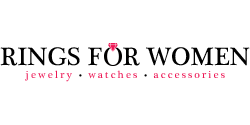A Guide To Diamond Cuts & Quality
Any guy about to begin the hunt for the perfect engagement ring is going to feel a bit overwhelmed by the issues he needs to understand. The cut of the stone, the size of the stone, the type of band, the style of the setting…yes, it is a lot to learn in order to buy just one ring. The thing here is that IF you go ahead and really understand this stuff now, it guarantees that you know how to buy good diamonds in the future too, and that will come in handy.
So, what are the essential things you need to know? Well, the first thing is the many ways diamonds are “cut” as this has a huge impact on their look, cost, and general style.
CHECK OUT DIAMOND RINGS AT AMAZON
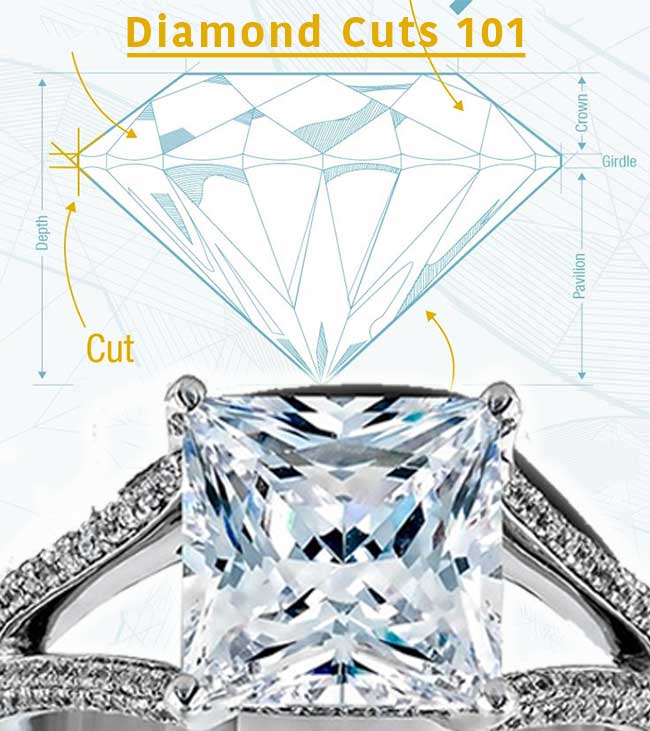
Diamond Cutting Explained
Any diamond that is cut is going to be made up of similar features or regions. These are:
- Facets – Depending upon the style of the cut, a diamond may have a lot of small cuts that create the reflections and sparkle. These are the facets, and they form the area of any diamond known as the crown.
- Crown – This is the uppermost part of the diamond, the “top” so to speak and it can be round, square, oblong, and many other shapes. If it features a single and large facet in the center, it is known as the table.
- Table – Some diamonds (like the emerald cut diamonds) will have a large facet atop the stone, and rather than calling it another facet, it is identified as the table.
- Girdle – The slim edge between the crown and the pavilion is known as the girdle, and it too is made of many small (almost undetectable facets).
- Pavilion – This is the bottom of the stone and is often conical in shape, though it can be fairly shallow with a blunt rather than pointed tip. When it is shaped like this it is described as having a culet.
- Culet – This is a polished or unpolished tip on a pavilion. It can be so blunt as to resemble a table, or it can be a relatively flattened point on a pavilion.
All diamonds feature most of these cuts. After that they are shaped.
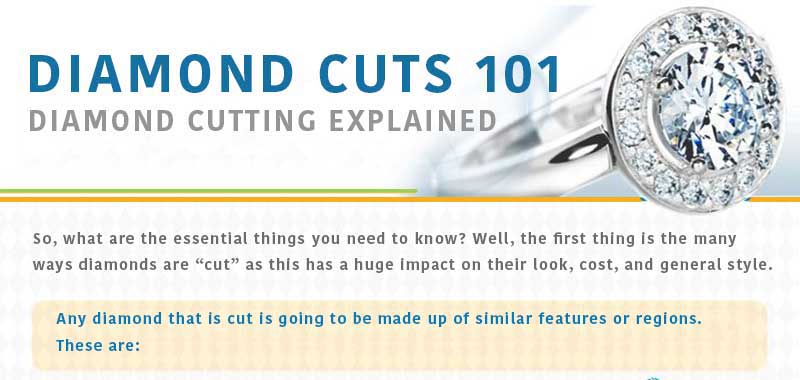
Diamond Shaping Explained
The most common shapes used in diamond cutting will include:
Round brilliant – 75% of diamond are cut in this way. They are round and made with many facets to emphasize reflections.
- Emerald – This is square and more rounded. It is an older style that is not so “blingy” but very tasteful.
- Radiant – A square stone meant to be as glittery as any round brilliant.
- Princess – This is another square stone that competes with the more glittery cuts.
- Oval – This can be rounded or pointed and can use large facets or many small ones.
Why so many shapes? It has to do with the amount of glitter desired, but it also helps to make a stone of low clarity to still look very good. Many facets can often hide “inclusions” and blemishes. This is why it is useful to understand the many cuts and shapes – you can really put them to use choosing the perfect engagement ring (and diamond jewelry) for your beloved!

Diamond Cuts – Part One
Diamonds are not “born” in their brilliant and glimmering state. They must be cut and polished to attain their impressive good looks.
Our goal here is the give you a full education of everything you need to know about diamond cuts so you can buy the perfect ring with the perfect diamond. But there are a number of misconceptions that we first must clarify.
For instance, you might say that a diamond cut is the way of describing its shape. That is correct, but only partially so. The cut is also going to affect the value of the stone because it will be the defining issue regarding its symmetry, its finish, and its general proportions.

Consider that a diamond is cut to have facets, which are the little disc-like cuts that give a stone all of its glitter. They also have to have a region known as the crown (which is the top), the girdle (which is the widest part of the stone), and the pavilion (the base beneath the stone that is often shaped like a cone.
This is when you can then add the idea of the “shape” to the equation. For instance, the most commonly seen shapes include the following:
- Asscher
- Cushion
- Emerald
- Heart Shaped
- Oval
- Marquise
- Pear Shaped
- Princess
- Radiant
- Round Brilliant
- Trilliant
One of the most commonly found cuts is the “round brilliant” which is the style that you will find around 75% of the time when looking commercially in stones. This doesn’t mean that it is the “best” way for a stone to be cut and shaped it is simply that it is a style very conducive to rings.

Pros and Cons of Cuts to Learn
This brings us to a brief look at the idea of “pros and cons” where the cut of a diamond is concerned. As we look closely at each of the cuts we’ll also list some of the benefits or negatives about selecting a particular style. For now, just stop to consider the cut of the stone in regards to the wearer’s comfort.
For instance, a round brilliant cut diamond is going to be one that stands out from the ring. This means you will want to consider if that will be a problem for the person who is going to want to wear it all of the time. Will they be able to wear it without getting it dirty, damaging it, or snagging things with the stone? There are a lot of issues relating to the ways that a cut diamond interacts with the wearer, and you have to base your decisions on all of the Four Cs but you cannot overlook the “wearability” of a piece of jewelry too. This might be a reason to go with an emerald or cushion cut as opposed to another style, etc.
In order to understand all of the most popular cuts, let’s take a look at them in detail in the next part of our series on diamond cuts, their benefits, and their minimum requirements.

Diamond Cuts – Part Two
Okay, so in Part One of this series you learned that there are actual “regions” on any cut stone. These include the crown, girdle, and the pavilion. When a diamond is cut with a very flat facet on top, it is called the table rather than the crown. When this flat fact is at the bottom of the pavilion it is known as the culet.
Keep those technical terms in mind as we begin to explore the various shapes as they will help you to visualize what you are learning about.
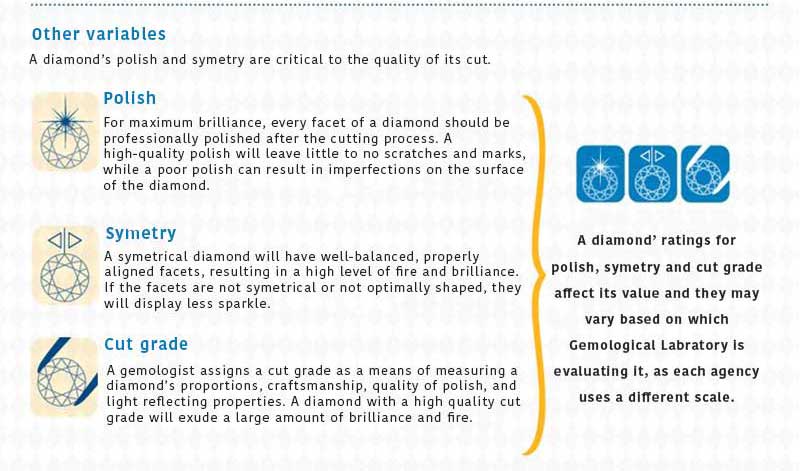
Asscher – Completely square in shape this is a cut that was not developed until the twentieth century. Professionals speak of it as a square emerald, and it too has the cropped corners that all emerald cut diamonds feature too. This cut brings the eye into the stone and does not offer as much reflective brilliance as other cuts. This means you have to use a nearly flawless stone to get the best results. We would suggest the following choices when electing to buy an Asscher cut stone: a minimum of G color and SI2 clarity with a setting that uses at least four prongs to ensure safety.
Cushion – Once considered entirely out of date and antiquated, you can now find the cushion cut diamonds outside of antique and estate sales. It can also be called the “pillow” cut, and it is oval in form with very large facets. Because of this is does not reflect the light in the same way as other diamonds and has more of an icy look. This is a style of cut that demands optimal clarity because you see so much of the stone’s interior. We would suggest the following choices when electing to buy a Cushion cut stone: a minimum of G color and VS2 clarity with a setting that uses at least four prongs to ensure the stone is stable.
Emerald – A true classic, this is a rectangular cut that was originally applied strictly to emeralds. Using it on a diamond is tricky because it can emphasize any inclusion or even cause them to break. The corners are cropped and the table is usually quite large. The manner of the cut makes this stone prone to longer flickers of light instead of displaying a lot of sparkle. We would suggest the following choices when electing to buy an Emerald cut stone: a minimum of one full carat, F color and VS2 clarity with a setting that uses at least four prongs to hold the stone, and small accents on either side to frame it nicely.
Heart Shaped – Not as common on a diamond ring, the heart shape is a very modern design. This cut often creates a remarkably fiery stone that reflects light beautifully, but it has to be done by a masterful cutter. This is why you want to know if the cutter can ensure that you receive a “good” cut along with a high quality stone. We recommend a G color with a clarity of nothing less than SI2.

Diamond Cuts – Part Three
You are beginning to get a good idea of the wide range of choices available. Let’s continue with more of the most popular and commonly selected cuts and shapes:
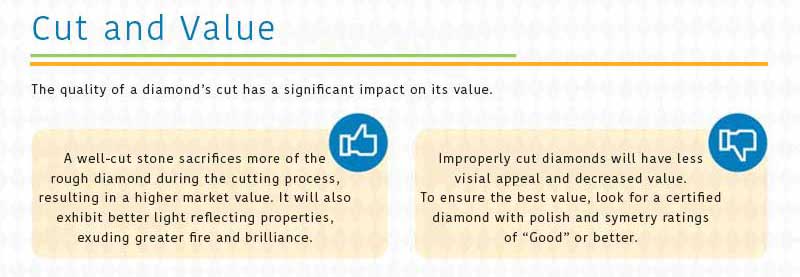
Oval – Not as square as the cushion cut, this is a true oval that is going to have a lot of similarities to the round diamonds. This is because they will be heavily faceted and will reflect the light like crazy. This is the ideal stone for the lady who loves her “bling” because it will be so brilliant. It is also a stone that doesn’t need to be perfect in order to look great. We would suggest the following choices when electing to buy an Oval cut stone: a minimum of G color and SI2 clarity with a setting that uses at least six prongs to ensure the stone remains firmly in place. These stones work nicely on their own but also make great companions to smaller stones too.
Marquise – This is a variant of the oval stone with pointed ends. This is the perfect cut for a solitaire ring because of the unique shape of the stone, but this is also a good choice if you want smaller diamonds in the band or on either side of the primary stone. We would suggest the following choices when electing to buy a Marquise cut stone: a minimum of G color and SI2 clarity with a setting that uses at least six prongs.
Pear Shaped – Also known as the teardrop, this stone uses a lot of different cutting techniques because of the inverted shape. All Pear Shaped stones are very fiery and reflective, but you must be aware of two common problems associated with this sort of cut: the bowtie effect and the uneven shoulder problem. The bowtie effect is a form of “shadow” that appears in the shape of a bowtie as you move the stone in the light, and yet it doesn’t appear and reappear in the same way as the other facets. You want to avoid a stone such as this. The uneven shoulders give the stone an angled look that ruins the fluid lines of the rounded end. This is not something easily remedied, so avoid it too. We would suggest the following choices when electing to buy a Pear Shaped stone: a minimum of G color and SI2 clarity with a setting that uses at least six prongs to keep the stone in place.
Princess – A lot of buyers don’t want a square cut stone because they don’t often compare with the amazing glitter of a round stone and its many facets. The Princess cut puts that issue to rest because it is cut very similarly to the Round Brilliant, but uses a square rather than circular form. It works nicely on its own but is even more attractive when framed by other diamonds and stones. We would suggest the following choices when buying the Princess cut stone: a minimum of G color and VS2 clarity with a setting that uses at least four prongs to ensure safety. Also be certain that the prongs protect the square corners as these are the points most likely to be chipped or damaged if left without protection.

Okay, we are almost done looking at diamond cuts. We now come to some of the most popular choices…
Diamond Cuts – Part Four
You probably have some ideas about the diamonds you will consider when you start to shop for an engagement or wedding ring. Let’s not overlook some of the most commonly selected of them all:

Radiant – Designed for maximum brilliance, this is a square or rectangular shape that can compete with any round stone in terms of glitter and fire. In addition to these benefits, the Radiant doesn’t demand the most flawless stones because it is heavily faceted. We would suggest the following choices when choosing your Radiant cut stone: a minimum of G color and VS2 clarity with a setting that uses at least four prongs to ensure the stone remains firmly in place. These stones work nicely on their own, but also look great when surrounded by accent stones. You should also be aware that it is challenging to find them in anything less than one full carat.
Round Brilliant – As you may remember from an earlier part of this series, the Round Brilliant cut is used on around 75% of diamonds sold. This is because it is a sure way of getting the most glitter and fire from even a poor quality stone. This means you can easily stretch the budget and get a primary stone and many accent stones if you use the Round Brilliant cut and stones with some color and inclusions. If you have a “sky is the limit” sort of budget, seek out an Ideal or a Signature Ideal stone in the Round Brilliant as these are nearly flawless and remarkably impressive. We would suggest the following choices when buying the Round Brilliant cut stone: a minimum of G color and SI2 clarity with a setting that uses at least four prongs.
Trilliant – If you are looking for something “different” this is the cut to use. It is a triangle that can have squared or rounded tips and which will have 25 facets on the crown with 19 on the pavilion. What does this mean? Lots of glitter and fire along with a unique and rare shape. This will certainly be a good option for the stone that sits by itself on the band, but it would look great with smaller accent stones too. We would suggest the following choices when electing to buy Trilliant cut stone: a minimum of G color and SI2 clarity with a setting that uses at least six prongs to ensure the stone remains firmly in place, also be certain that the prongs protect the square corners as these are the points most likely to be chipped or damaged if left without protection.
Okay! Now you know all about the cuts used for diamonds and all of the most popular shapes. You understand which might cost a bit more and which might be the wiser choice for your lady. Have a bit of fun with the shopping experience, think about the recipient’s personal style, and use this information to make the perfect choice. More jewelry tips here.
